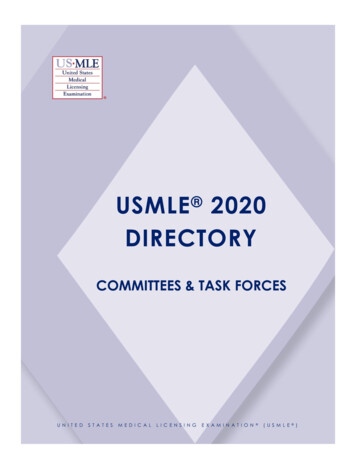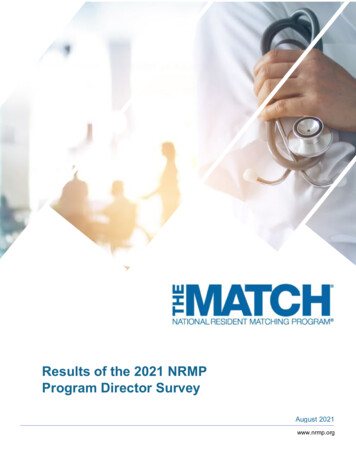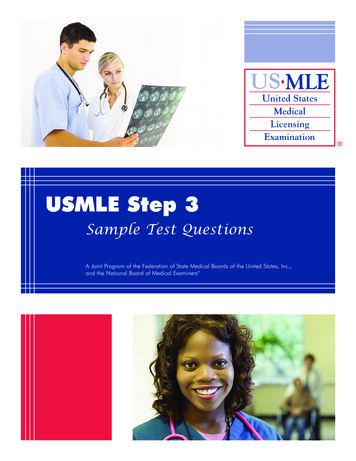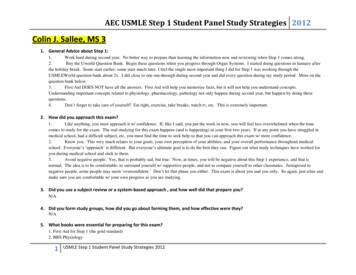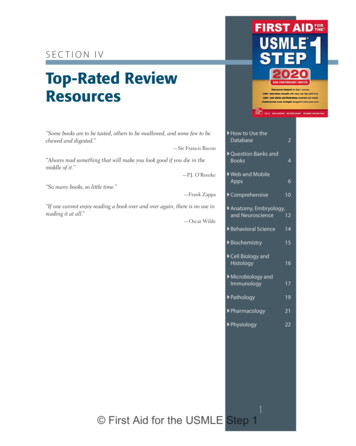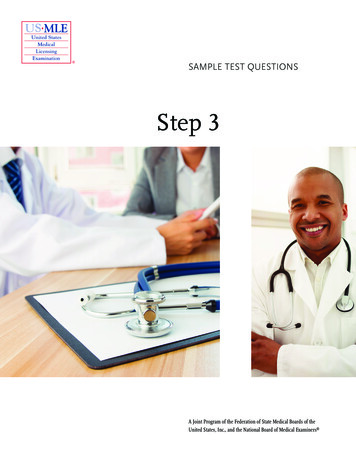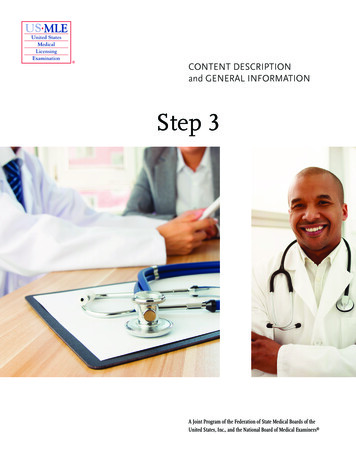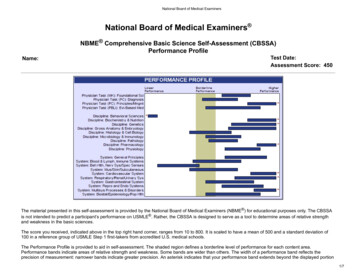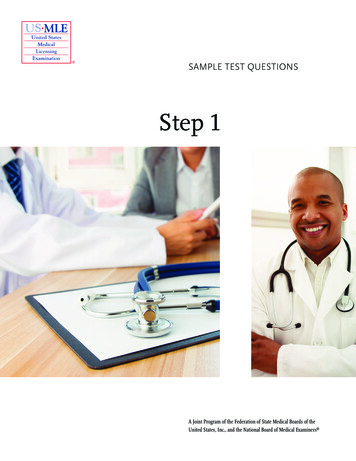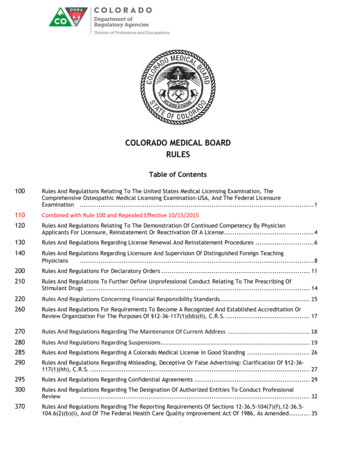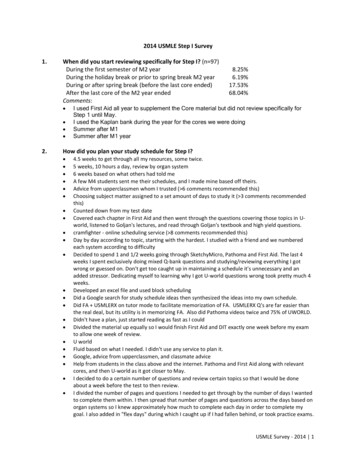
Transcription
2014 USMLE Step I Survey1.When did you start reviewing specifically for Step I? (n 97)During the first semester of M2 yearDuring the holiday break or prior to spring break M2 yearDuring or after spring break (before the last core ended)After the last core of the M2 year endedComments: 2.8.25%6.19%17.53%68.04%I used First Aid all year to supplement the Core material but did not review specifically forStep 1 until May.I used the Kaplan bank during the year for the cores we were doingSummer after M1Summer after M1 yearHow did you plan your study schedule for Step I? 4.5 weeks to get through all my resources, some twice.5 weeks, 10 hours a day, review by organ system6 weeks based on what others had told meA few M4 students sent me their schedules, and I made mine based off theirs.Advice from upperclassmen whom I trusted ( 6 comments recommended this)Choosing subject matter assigned to a set amount of days to study it ( 3 comments recommendedthis)Counted down from my test dateCovered each chapter in First Aid and then went through the questions covering those topics in Uworld, listened to Goljan's lectures, and read through Goljan's textbook and high yield questions.cramfighter - online scheduling service ( 8 comments recommended this)Day by day according to topic, starting with the hardest. I studied with a friend and we numberedeach system according to difficultyDecided to spend 1 and 1/2 weeks going through SketchyMicro, Pathoma and First Aid. The last 4weeks I spent exclusively doing mixed Q-bank questions and studying/reviewing everything I gotwrong or guessed on. Don't get too caught up in maintaining a schedule it's unnecessary and anadded stressor. Dedicating myself to learning why I got U-world questions wrong took pretty much 4weeks.Developed an excel file and used block schedulingDid a Google search for study schedule ideas then synthesized the ideas into my own schedule.Did FA USMLERX on tutor mode to facilitate memorization of FA. USMLERX Q's are far easier thanthe real deal, but its utility is in memorizing FA. Also did Pathoma videos twice and 75% of UWORLD.Didn't have a plan, just started reading as fast as I couldDivided the material up equally so I would finish First Aid and DIT exactly one week before my examto allow one week of review.U worldFluid based on what I needed. I didn't use any service to plan it.Google, advice from upperclassmen, and classmate adviceHelp from students in the class above and the internet. Pathoma and First Aid along with relevantcores, and then U-world as it got closer to May.I decided to do a certain number of questions and review certain topics so that I would be doneabout a week before the test to then review.I divided the number of pages and questions I needed to get through by the number of days I wantedto complete them within. I then spread that number of pages and questions across the days based onorgan systems so I knew approximately how much to complete each day in order to complete mygoal. I also added in "flex days" during which I caught up if I had fallen behind, or took practice exams.USMLE Survey - 2014 1
I made a calendar/schedule and tried my best to stick to it. Doing it this way ensured that I gotthrough everything I wanted to get through.I made out a calendar in google calendar with build in "catch-up" days and stuck to my schedule asclose as possible.I multiplied the pages I needed to cover in first aid by the number of times I wanted to study themand divided those by the days I had to study.I only had time to prepare for step 1 after the last M2 exam.I planned my schedule based on how many weeks I had to study at a rate of 10 hours per day.I planned to cover 20 pages of First Aid per day. I would study in the mornings and do UWorldpractice questions in the afternoons. This gave me enough time to take each Sunday off and left aweek prior to the test to focus on weak areas. I also took a practice exam each week on what wouldbe my testing day (Tuesday) to track my progress.I planned to study for 37 days, which I charted and planned via an excel document schedule. My goalwas to get 12 hours of studying in per day, which I broke up into three 4 hour blocks with smallbreaks between. The first block was a quick review of the previous day's practice questions, and arapid review of the previous day's first aid section. The second block was all new first aid studying.The third block was two hours of continued first aid studying, and two hours of practice questions.Overall, I made it through First Aid twice from cover to cover, plus reviewed a few sections that I wasweek in as the test got closer, as well as approximately 1400 questions from a mixture of U-world andUSMLE-Rx.I read the USMLE first aid, and did USMLE world practice questions alongside it.I researched study plans online, asked older students who performed well on the exam, andconsidered my own expectations for the exam and then decided how hard I needed to study to getthe score I wanted. Based on that, I developed my plan and went to work.I scheduled an appointment with a private advising service.I scheduled each topic in First Aid a couple of days each. In those days I would go through the FirstAid chapter and supplement the material with other review materials as needed. Every day I wouldalso complete a block of questions from the U-world q bank and review the questions. Every day Iwould also go through 10-20 pharmacology flash cards. Each Saturday I would do a complete orpartial practice exam and review material/questions as needed.I structured my schedule using Pathoma lectures - I chose which allotted about 4 chapters per weekand focused on those topics, using Pathoma, First Aid, Uworld Qbank and pharm flashcards.I took a practice test and planned my strategy from there. I also followed Doctors in TrainingI tried to get through First Aid.I tried using Cramfighter but ended up deciding on my own that I would spend the first two weeksdoing Doctors in Training and the second two weeks focusing on USMLE World questions.I used exam crackers to help schedule when I did thingsI used Google to pool multiple suggestionsI used the website program called CramFighter. You input the books and #of questions you want toget done and it tells you how much needs to be done every day to reach that goal.I would do 2 46 question sets (random) per morning, 5-6 hours of DIT, an hour of Pathoma, 30 minsof Sketchy micro, and 1-2 Goljan lectures per day (while in the car or taking a walk). I did thisMonday-Thursday. Fridays I took an NBME exam. Sat and Sunday I set aside to go through all thequestions I had done that week, writing in a notebook notes about all the incorrect and correctanswers. I would review the explained answers in the q-bank but also look up the topics covered infirst aid, Wikipedia, and a pharmacology text book question by question.Looked at what other people had done successfullyLooked online for suggested schedules and divided sections into 3 hour sessions, with 2 weeks forreview of all materialMy brother sent me a study chart that he used of how to plan out blocks of time.On a sheet of paper.Pathoma First Aid U-world USMLERX NBMEUSMLE Survey - 2014 2
3.Did you utilize the UNMC exam feedback reports to guide your studying (i.e., more focus onareas of weakness)?6 of 93 (6.06%) students used it. Comments on how they used it are listed below:Of those who used it, they explained how 4.Planned to cover study materials 2 times in my allotted study time.Pretty much just 8-5 every day, reviewed first aid and did U World twicePrevious student-generated scheduleSat down with two other guys in my class, decided what topics we all struggled with and made thosea priority to study first. Then filled in the blanks after that. Tried to group things like neuro and psychtogether or cardio and renal because they were closely related.Set aside the number of days I had and divided what I wanted to go through.Tried to do questions during the cores, then cracked down during the month after schoolU-world question sets to correlate with FA sectionsU-world questions, sketchymicro, Dr.'s in Training, Pathoma, and First AidWatched videos to review for the first two weeks, then focused on review questionsWinged it and the world wide web helped a little. I tried to read as many first aid pages as I could getthrough in the morning, then do U-world questions the rest of the day, and sprinkle is some U-worldself assessments and NBME exams.With a friend who had a schedule from a past m3Wrote out an outline of weaknessesI didn't use them extensively, just checked to see what areas I was weaker in.I focused on my weak areas.I just observed which areas were my weakest and targeted those areas to be covered first in my studyschedule and at least twice in my study plan.I spent extra time on the areas I was weakest.I wrote down areas where I scored worse--but the categories were so general that it was morehelpful to just see the organ system I needed to work on.While they may be helpful for students that miss large sections, students who only miss a couple ofquestions in each section doesn't really help narrow anything down.Please indicate which item(s) you used that were most helpful and which were least useful(Items are in descending order of Most Helpful percentage of respondents):CountFirst Aid for the USMLE Step IUSMLE World question bankPathomaDoctors in TrainingUSMLE/NBME websites (question banks)Goljan lecturesPharmacology Flash CardsUSMLE-Rx (First Aid)Goljan Pathology Review bookFirecrackerKaplan Q BankBoard Review Series (LWW publisher)Kaplan High Yield review99999991919090928888918888CountDid notuse0%5%24%53%47%66%64%80%84%90%85%80%92%Did SMLE Survey - 2014 3
useAppleton & Lange Review for the USMLE Step IExam Master online (McGoogan Library website)Kaplan Medical USMLE Step I bookUNMC syllabus materialHigh Yield series (LWW publisher)USMLE Road Map series (Lange)USMLE Step I Recall: Buzzwords for the lpful0%7%2%8%4%1%1%1%1%1%1%0%0%0%The following items were not used by any students: NMS Review for USMLE Step I Series, Princeton Review, Step-Up,Underground Clinical Vignette Series, USMLEasy.Additional Resources 5.First Aid: Organ Systems (somewhat useful)Lange Biochemistry Flash Cards, Lippincott MicrocardsMicro Flashcards Most UsefulNBME practice test - most usefulPicmonic was very useful.Sketchy Micro. It is an online website with lectures on the types of bacteria. I consider that theonly reason I knew the bacteria so well and I will recommend it to everyone I know.For review books or websites you used, please comment why particular resources were mostuseful. Doctors In Training helped a lot. I just did a lot of USMLE questions w it.Doctors In Training made me an awesome calendarDoctors In Training was well structured and engaging, which made scheduling easyFirecracker offered an economical way to review reflexive type information year around.First Aid - An organized, condensed, concise review of everything. I bought the most recent availableFirst Aid at the beginning of first semester M2 year and used it as a guide/reference throughout theyear. I tried to make a point to have at least read through the related section before/during each coreexam and ideally have taken some notes in it. If you keep up with it throughout the year, it's moredigestible, as well as a review rather than your first exposure. I didn't/wouldn't bother getting thenewest version of First Aid before the test. I think the value of using and getting comfortable with acopy throughout the year outweighs any value from the small changes or updates of a newestversion. Pathoma - Dr. Sattar is great. He clearly has passion and skill for teaching. I also bought thisat the beginning of first semester M2 year and used it throughout the year. He often explains the whyof pathologies such that it sticks with you, which is clearly helpful for both core exams and boards.Especially when you buy these resources early, I think they really breakdown to being worth themoney.First Aid and Pathoma are very good resources. Both are very thorough and contain pertinentinformation.First Aid certainly doesn't have everything you need to know for the test, but it lays the groundworkout very well and is important to go through multiple times throughout the year and your dedicatedstudy time. Pathoma-gives great explanations on how and why the pathology of certain diseases isthe way it is which is critical for Step 1First Aid condenses complex topics and organizes the information nicely.First Aid contained the necessary material and Doctors In Training helped me develop an approach,which was probably the most essential component. U-World was great for assessing knowledge gapsand practicing application of what you know. It gave a window to how a given topic can beapproached by a test maker and wrapped within a question stem.First Aid covered the most high yield topicsFirst Aid covers the high yield topics and is a good general review material. Goljan lectures were niceto listen to while exercising or doing other activities. Pathoma is especially helpful if used throughoutUSMLE Survey - 2014 4
the year by watching the lectures for topics that are being covered in class. Pathoma is probably alittle more detailed than required for Step 1 on some topics.First Aid- essential but not complete. Supplement with another book like Kaplan reviewFirst aid had exactly what was needed with no extra fluff.First Aid has a lot of high yield topics and does a great job with pharmacologyFirst aid has all basic info and Pathoma explains pathology very clearly.First aid has all the details you need, the problem is it doesn't explain much. UWorld gives awesomeexplanationsFirst Aid has almost everything needed for the exam, but Doctors in Training helped to fill in thespaces that First Aid did not cover. Picmonic is a great resource for visual learners like myself.Pathoma has always been a great pathology resource because of the high yield facts and easy tofollow lectures.First Aid has been doing this for so many years that they have it down pretty good as to what is goingto be on the test. Pharmacology flash cards (Lange) were great at presentations and presenting highyield facts. I would compare them with First Aid but it was nice to stare at a different type of paperother than a book.First Aid- is a mustFirst Aid is a must have although it should not be the only resource used as it is missing someinformation. The Goljan review book was helpful for me both during classes and in studying to helpme understand material I did not fully understand since it is more specific than First Aid and somenotes.First Aid is concise while also comprehensive. Pathoma videos helped create visual mnemonics formore complex pathology and some normal physiology.First Aid is great because of everything it contains but use it as a reference for learning. Staring at achapter for an hour did nothing for me. Doing Uworld questions and going back to first aid to learnwhy I got it wrong was the most beneficial for meFirst Aid is helpful to go through a few times to nail down the basicsFirst Aid is pretty indispensable as far as a concise overview of the must know information. Probablybest if used with some sort of supplement since it doesn't provide a lot of explanation - this can oftenbe accomplished with a simple Google search though for the areas you don't understand.First Aid is the only actual textbook you needFirst Aid is the single most effective book for studying for Step 1 that I was able to find. I looked at afew other options as well, but ultimately chose FA and was glad that I did. Regardless of how Iactually performed on the exam, I didn't feel completely blind-sided by any question (to which I givecredit to both First Aid and our first two years of lecture, as they both played a huge role in this). TheBiochemistry and Microcards were extremely valuable. They really simplified very diverse topics anddid a good job targeting important concepts Pathoma was very useful as well, reinforcing ideas laidout in first aid but in a "study-guide" format.First Aid is undoubtedly the bible. It is the densest and the highest yield board review book.Pathoma with online lectures helps explain the pathophysiology extremely well.First Aid provides a good framework and USMLE world questions give both self-assessment withexcellent feedback on their questions.First Aid really hits on the stuff you're likely to see on the test.First Aid should be your Bible; any other resources are merely to clarify material or, if there is time,continue to add depth to your knowledge. You can easily get overwhelmed with material.First Aid was a great outline and the q banks helped fill in the holes.First aid was concise and very high yieldFirst Aid was concise yet detailed with useful pneumonicsFirst Aid was nice because it covered everything succinctly.First Aid was very helpful in covering the high yield concepts.USMLE Survey - 2014 5
First Aid, and the First Aid General Principles and Basic Sciences books were very well organized andas concise as possible. The many diagrams/charts were applicable. First Aid also has a rapid reviewthat was beneficial.First Aid: Useful for reference but it wasn't my primary resource for studying Pathoma: greatoverview of all systems. Perfect for quickly reviewing deficient areas Sketchymicro.com: Thoroughand easy way to learn microbiologyGoljan lectures are great to listen to while still in school (and while studying for Step1 specifically)because he has a great way of making things understandable and really helps solidify concepts welearn throughout 2nd year First Aid is thorough, but also keeps things simple. gooddiagrams/tables/charts for reviewNBME examsPathoma and First Aid were the bestPathoma is a fabulous pathology review, but it is not the only pathology review you should use. Firstaid is a must have.Pathoma is a great review course, but also a good review book. The book is set up as an outline thatmakes it easy to follow and put information in easy to remember groups.Pathoma is the thing to use throughout the year for basic understanding. DIT is necessary for thedesiccated timePathoma- very concise. Videos explained concepts behind a lot of the pathologyPathoma was a great review, it provides a good way of thinking about things so they are easier toremember.Pathoma, first aid and U-world. Wouldn't waste my time on anything else.Patrons was great for reviewing pathology and going through during second year. First aid was usefulas a general overview of everything. Goljan was good for more in depth pathology review.Sketchy micro easily got me all the micro points on the exam. The videos are funny and actuallyseemed like a break when I watched them. Pathoma was incredibly helpful to watch when I could notdo work anymore. It was really helpful for me to confirm my knowledge or fill in gaps but can bereally dense sometimes to use as first line learning. First aid is great, gold standard but I was not ableto just sit and read it. I annotated it and reviewed it a few days before so that was good. I also renteda pharm review book from the library and it was helpful for just driving home some concepts ofpharm that I needed.The books did a good job of covering all the material in a condensed format, DIT was helpful in termsof keeping me on track to make it all the way through the material, and Pathoma was a nice review ofthe high yield information on the test.The most thorough reviews were the most helpful. The "high-yield" reviews like First Aid and otherswere good as a re-introduction to the subjects before digging deeper into them in the BRS and Goljanreview.They are simply the best resources. First Aid has everything you need to know, and Dr Sattar givesyou the information that is most high yield with Pathoma.They hit on the main points and either helped me remember what I had learned about a given topicor made me realize that the information given wasn't enough and that I need to study a topic morebecause I didn't understand it well.USMLE world was very similar style to the Step 1 questions. Also, the First aid for USMLE step 1 wasvery helpful to me, i thought it covered almost everything on my exam.U-worldU-world and first aid are most helpful. Brs physiology was excellent for review of difficult organsystems. Goljan path book helped review somewhat. Micro flash cards and pharm flash cards are alsohelpful.U-world questions helped point out weaknesses and were more thorough than other resourcesU-world questions made you make sure you really understood the material, and first aid was concise,great pictures and helpful memory tipsUSMLE Survey - 2014 6
6.For board review courses (either live or online), please comment why the course was mostuseful. Because Pathoma was a lecture series, it emphasized info that I might have overlooked in First Aid,and it presented a different point of view on many topics that was more thorough and better tounderstand than First AidDIT - I appreciated the structure DIT offered. Although they for the most part do just walk you (oftenverbatim) through First Aid, I don't think I would have been as focused simply sitting down with FirstAid. They also sometimes offer alternative ways to think about or remember things and have littlequizzes that force you to repeatedly review. Goljan lectures - Great to listen to anytime you need tobust outside and walk or exercise. He hits a lot of important stuff, pulls things together and is usuallygood for a laugh.DIT built review into the program and emphasized which concepts were most important, which wasvery helpfulDIT constantly quizzes you over old and new information which was the best part of the course.DIT gave me a structured method of getting through First Aid for the first time.DIT helped keep me from falling behind in my schedule. It also gave the highest yield information.DIT incorporated a schedule and had multiple review questions with entertaining videos to keepattention.DIT instructors were funny enough that I didn't fall asleep listening to lectures. Which was importantwhen I was watching 8 hours of lectures a dayDIT is boring, so be prepared. I used it for one day then stopped using it. I read through it a bit anddidn't see anything that was of use.DIT is useful because it is well structured and thorough.DIT- only good to help keep a good schedule and good for review of complex topicsDIT works great for laying everything out in an engaging way. It connects the pieces together andforces you to remember what you reviewed from previous lectures.Doctor in Training walked me through the important materials efficiently.Doctors in Training- Comprehensive review covering material not covered in class. Verystraightforward in what is tested and what is not. Keeps you on track. Would recommend to anyonetrying to get a high score. UWORLD and FA are obviously the standardDoctors in Training is a great resource. They are not as fine tuned as First Aid but they do fill in thegaps that First Aid doesn't cover. They have a great way of explaining how you can think throughcertain problems and help make you recall information. Kaplan Online just lists facts and might aswell be an extended First Aid. I would honestly say its a waste of money.Doctors in Training videos expanded upon and supplemented First Aid well, and allowed for moreactive learning than simply reading through First Aid.Doctor's in Training was a good way for me to force myself to get through First Aid the first time.Some of the information was extraneous but it was a helpful way to review the information initially.Doctors in Training was a waste of money. Study first aid on your own if you have the motivationDoctors in Training was concise, their videos were brief, and their presentation was memorable. Theywere deft at making a topic stick and constructing their video material around the attention span ofthe viewer. Topics designated as high yield were deconstructed into exercises, like Lewis notes, andthe student was often challenged to recall the information. That was helpful.Doctors in Training was most useful because it helps get through your first pass of First Aid quicklyDoctors in Training: I used it to provide a broad overview of all topics during the first couple weeks ofstudying. I thought it was good for that purpose but I didn't go very in depth with it.Doctors-in-Training covered a wide variety of topics and helped point out which things may be moreimportant than othersGoljan explains concepts wonderful. Helped to understand material instead of memorizingGoljan lectures are good for listening to when you're working out or driving, etc. He gives some reallygood explanations on things and ties in different areas together instead of just pathology.USMLE Survey - 2014 7
7.I did Kaplan review courses and they were helpful.I listened to Goljan when I could (in the car, on walks, while cleaning my apartment) and, limePathoma, it was a great way to reinforce and commit info to memory and fill in gaps.Not useful at all unless it's PathomaPathoma - great bridge into the pathology sections of First Aid. Offers really nice explanations thatutilize concepts to help memorize the pathologic findings. Very useful for the M2 cores as well. DIT- lectures are a good supplement for First Aid; forces you to memorize some details that you may nothave otherwise. I didn't think the extra information that DIT had in its study guide was very high yield.Pathoma provided a very concise and very easy to understand overview of many elements ofpathology. It connected many areas and focused on diseases.Pathoma was a great pathology review. The lectures and textbook are both very concise. The lecturerprovides useful ways to think about and remember difficult topics.For question banks, please comment why the question bank was most useful. Feedback and explanations from U-world were really helpfulI felt U-world had good explanations for questions and covered most of the material that showed upon the NBME tests. I felt that the actual Step1 exam was much more difficult than would beindicated by the NBME/USMLE.org exams. I haven't received my USMLE score yet, but I would feellucky to score within 20 points of my last 2 NBME examsI used Kaplan during the year and did as many questions as I could to reinforce what we were doing inclass. I liked this because I was able to use the questions to LEARN and identify patterns within asubject. I used the USMLE world Q-bank to TEST myself and get an idea of where I was at. I only everused 46 question random testlets with U-world. Additionally I bought two physical books of questions(one Kaplan and one that follows first aid). I used these physical question books starting over springbreak to just fill in. These were good for learning and testing and were really great when I wastraveling, wanted to sit outside/on the couch, or when my eyes could not look at a screen anymore.I'm a huge proponent of limiting my screen time.Need to do either Kaplan or Rx during the year and U-world during dedicatedplenty of questions, good qualityPractice questions are the best way to learn, especially since U-world explanations are so detailed.Practice reading and interpreting board-style questions.Q-bank gives very detailed answers. I used this as review and a learning tool. Spend time learningwhat you get wrong and you will eventually get smarter, even if you don’t feel like you are.Q's much like the testQuestions are the best way I learn and remember what I learn so qbank was good obviously becauseit had so many.Realistic questions from U-world. Kaplan not as much- often focused on memorization ofminutiae/triviaThe format of USMLE World Question Bank is exactly the same as the real exam. The questions are alittle harder than the real ones and they are all very well explained.The most helpful aspect of U-world was it's comprehensive question information. Wrong answerswere explained and topics were thoroughly reviewed.The USMLE question bank was useful because it provides an explanation for each question whichhelps you continue to review as you are studying new material.The U-world Q Bank was tremendously more useful than the Kaplan Q Bank. The Kaplan Q Bank Didnot offer easily accessible explanations to why each answer option was incorrect, while the U-worldQ bank did. Essentially, in a sample question that had five potential answer options, you got five fullexplanations, unlike Kaplan.U world- many questions (2000 ) and good explanations of the correct and incorrect answers.USMLE and NBME were exactly like the exams. I felt very comfortable during the test.USMLE Q bank only because I used it most.USMLE Survey - 2014 8
USMLE World - only q-bank I tried so I can't compare it to anything. But it offered challengingquestions with excellent explanations for both the right and wrong answers. Can learn a lot just fromreading through those.USMLE World asks very difficult questions but provides great feedback. Some material is extraneousbut overall it is an essential resource.USMLE World has an extensive question bank with very thorough explanations.USMLE World is a must. I felt many of my actual questions from Step 1 were worded similarly to Uworld.USMLE World question bank is a must-have as it lets you go through over 2,000 boards-stylequestions and gives full explanations. I learned most of the information I didn't know by using thequestion bank.USMLE World questions were very similar to actual test questions.
USMLE Survey - 2014 1 2014 USMLE Step I Survey 1. When did you start reviewing specifically for Step I? (n 97) During the first semester of M2 year 8.25% During the holiday break or prior to spring break M2 year 6.19% During or after spring break (before the last core ended) 17.53%
